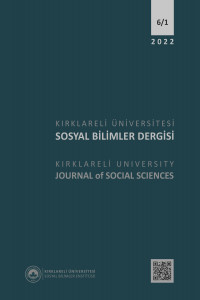Banka Kredilerinin Ekonomik Büyüme Üzerindeki Etkilerinin İncelenmesi: G-20 Ülkeleri Örneği
Kredi, Beşeri Sermaye, Ekonomik Büyüme, G-20 Ülkeleri
Investigation of The Effect of Bank Credits on Economic Growth: The Case of G-20 Countries
: Credit, Human Capital, Economic Development, G-20 Countries,
___
- Akçayır, Ö., Albeni, M. (2016). Türkiye’de Kredi Genişlemesinin Cari Açığa Etkisi: Sınır Testi Yaklaşımı. Çankırı Karatekin Üniversitesi İktisadi ve İdari Bilimler Fakültesi Dergisi, 6 (1) , 557-583.
- Ağır, H., Tıraş, H. H. (2018). Sağlık Harcamaları ve Ekonomik Büyüme İlişkisi: Panel Nedensellik Analizi. Gaziantep University Journal of Social Sciences, 17(4), 1558-1573.
- Apak, S, Yılmaz, G. (2010). G-20 Ülkeleri ve Küreselleşme. Muhasebe ve Finansman Dergisi, (46) , 11-24.
- Apaydın, Ş. (2018). Türkiye'de Banka Kredilerinin Ekonomik Büyüme Üzerindeki Etkileri. Ömer Halisdemir Üniversitesi İktisadi ve İdari Bilimler Fakültesi Dergisi, 11 (4), 15-28.
- Becsi, Zsolt ve Wang, Ping (1997). Financial Development and Growth. Federal Reserve Bank of Atlanta Economic Review, Fourth Quarter, Vol. 82, Iss. 4, s. 46-62.
- Beck, T., Levine, R., Loayza, N. (2000). Finance and the Sources of Growth. Journal of Financial Economics, 58(1-2), 261–300.
- Choi, I. 1994. Durbin-Hausman Tests for Cointegration. Journal of Economic Dynamics and Control, 18(2), 467–480.
- Choi, In, 1992. "Durbin-Hausman Tests For A Unit Root. Oxford Bulletin of Economics and Statistics. Department of Economics, University of Oxford, vol. 54(3), 289-304.
- Çamoğlu, S., Akıncı, M. (2012). Türkiye’de Sektörel Banka Kredilerinin Gelişimi: Bir Zaman Serisi Analizi. Yönetim ve Ekonomi Dergisi, 19 (1), 193-210.
- Dünya Bankası Veri Tabanı (2021). Erişim adresi: https://www.worldbank.org/en/country/turkey/overview
- Emirmahmutoğlu, F. ve Köse, N. (2011). Testing for Granger Causality in Heterogeneous Mixed Panels. Economic Modelling, 28, 870-876.
- Gür, N., & Dilek, Ş. (2018). On Yılın Muhasebesi Başarıları ve Hayal Kırıklıklarıyla G20. Seta Siyaset, Ekonomi ve Toplum Araştırmaları Vakfı (262), 7-21.
- Güzel, S. (2009). 2008 Küresel Ekonomik Krizi ve IMF’nin Önerdiği Ekonomi Politikalarının Krizle Mücadeledeki Rolü. Uludağ Üniversitesi İktisadi ve İdari Bilimler Fakültesi Dergisi, (2), 55-69.
- Göçer, İ., Mercan, M., Peker, O. (2014). Kredi Hacmi Artışının Cari Açığa Etkisi: Çoklu Yapısal Kırılmalı Eşbütünleşme Analizi. Istanbul University Econometrics and Statistics e-Journal, 0 (18), 1-17.
- Hacıgökmen, F. (2019). Ekonomik Kırılganlıklar; G-20 Ülkeleri Üzerinde Bir İnceleme. Politik Ekonomik Kuram, 3 (2), 192-213.
- Hacıimamoğlu, T., & Sandalcılar, A. R. (2020). The Effect of Renewable Energy Consumption on Economic Stability: Panel Data Analysis on Selected Countries. EMAJ: Emerging Markets Journal, 10(1), 10-20.
- Karakurt, B., Şentürk, S. H., Ela, M. (2015). Makroekonomik Kırılganlık: Türkiye ve Şangay Beşlisi Karşılaştırması. Yönetim ve Ekonomi Araştırmaları Dergisi, 13 (1), 283-307.
- Kalaycı, İ. (2012). Finansal Kriz Konjonktürü (2007–2009) ve Küresel Ticaretin Anatomisi. Avrasya Etüdleri 41 (1), 145-182.
- Karaçayır, E., & Karaçayır, E. (2016). Yurtiçi Kredi Hacminin İşsizlik Üzerindeki Etkisi: Türkiye Uygulaması. KMÜ Sosyal ve Ekonomik Araştırmalar Dergisi, 18(30), 13-18.
- Lopez, J. H. (1997). The Power of The ADF Test. Economics Letters, 57(1), 5–10.
- Maddala, G. S., & Wu, S. (1999). A Comparative Study of Unit Root Tests with Panel Data and A New Simple Test. Oxford Bulletin of Economics and Statistics, 61(s1), 631–652.
- McKinnon, R.I. (1973). Money and Capital in Economic Development. Brookings Institution Press, Washington, DC.
- Meltzer, A. (1960). Mercantile Credit, Monetary Policy, and Size of Firms. The Review of Economics and Statistics, 42, 429.
- Özen, E., Vurur, N. (2013). Türkiye’de Mevduat Banka Kredisi ve Ekonomik Büyüme İlişkisinin İncelenmesi. Uşak Üniversitesi Sosyal Bilimler Dergisi, 6 (3), 117-131.
- Öge Güney, P., Turgut, K. (2020). Banka Kredi Hacmi ile İktisadi Büyüme Arasındaki İlişki: Türkiye Örneği. Kafkas Üniversitesi İktisadi ve İdari Bilimler Fakültesi Dergisi, 11 (21), 353-386.
- Pesaran, H., Yamagata, T. (2008). Testing Slope Homogeneity in Large Panels. Journal of Econometrics, 142, 50–93.
- Pesaran, M. H. (2004). General Diagnostic Tests For Cross Section Dependence in Panels. CESifo Working Paper Series No. 1229; IZA Discussion Paper No. 1240. 1-39.
- Saarenheimo, T. (1995), Credit Crunch Caused Investment Slump? Bank of Finland Discussion Papers, 6/95, 1-27.
- Schumpeter, J.A. (1912). The Theory Of Economic Development: An İnquiry İnto Profits, Capital, Credit, İnterest, And The Business Cycle, Cambridge. Harvard University Press.
- Shaw, E. S. (1973), Financial Deepening in Economic Development. Oxford University Press, New York).
- Swamy, P. A. V. B. (1970). Efficient Inference in A Random Coefficient Regression Model. Journal of The Econometric Society, 311-323.
- Tuna, K, Bektaş, H. (2014). Kredi Hacminin Ekonomik Büyüme Üzerindeki Rolünün İncelenmesi: Türkiye örneği. Finansal Araştırmalar ve Çalışmalar Dergisi, 5 (9), 139-150.
- Ünal A., Kaya, H. (2009), Küresel Kriz ve Türkiye. Ekonomi ve Politika Araştırmaları Merkezi, İstanbul
- Yayın Aralığı: Yılda 2 Sayı
- Başlangıç: 2017
- Yayıncı: Kırklareli Üniversitesi
Mihmân-nâme-i Buhârâ: Muhammed Şeybânî Han’ın Padişahlığının Tarihi (IX. ve X. Yüzyıl)
Erken Budist Etiği-Doktrini ve Disiplini /Early Buddhist Ethics- Its Doctrine and Discipline
Beyond Food Prices: An Analysis On Sub-Indices
Banka Kredilerinin Ekonomik Büyüme Üzerindeki Etkilerinin İncelenmesi: G-20 Ülkeleri Örneği
Türk İstiklal Harbinde Karadeniz
Yardımcı Ders Materyali Olarak Posta Pulları
